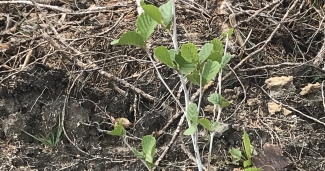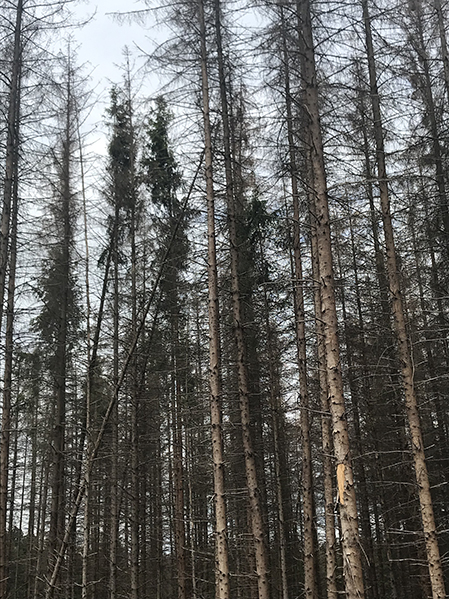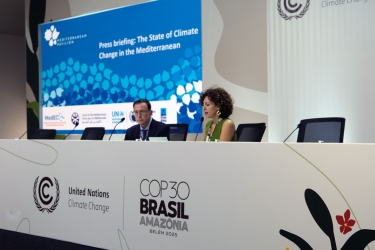Database of Forest Disturbances in Europe

by Mart-Jan Schelhaas, Wageningen Environmental Research
What if we had a database covering all forest disturbances in Europe over the past 170 years? Would we be able to identify patterns of old disturbance regimes, analyse how they have changed over the years with forest management and climate change, and make predictions on how the future disturbances will look like? Could we be better prepared for what is to come?
Forest disturbances in Europe are as multifold as forest types, depending on the geographic location, vegetation zone and forest management regimes – and they have been heavily increasing in the past decades. Factors such as climate change and human influence add to the number of disturbance events and their impact on the forest. Forestry has deep roots in the European history, and recordings of major disturbance events are available dating back many centuries. Despite this, a complete picture of forest disturbance events in Europe was for long missing, as a large amount of the information is available on a regional and/or national scale, but it is usually scattered over many sources.
The European Forest Institute (EFI) in collaboration with Wageningen Environmental Research (then Alterra) identified this gap already 20 years ago – and aimed at closing it both for providing a basis for comparison of disturbance regimes in different countries and time periods and for modelling possible impacts of climate change. This was the hour of birth of the Database of Forest Disturbances in Europe (DFDE). The database covers all the reported forest disturbance events that were found in an extensive literature search. The earliest records date back more than 5 centuries but the majority of the data covers the period from 1850 to 2000. It was published with the title “Natural disturbances in the European forests in the 19th and 20th centuries” in 2003 in the journal Global Change Biology. However, due to lack of funding, the foreseen continuous updating of the database was halted, although the paper is still quite frequented, with 540 citations altogether, and ca. 160 citations in the past two years.
For quite some time DFDE was indeed the only European database on forest disturbances. A couple of countries have their own national databases, but often there is no systematic monitoring of disturbances, just single reports if something happened. Only for fires there is a European system (EFFIS), maintained by the Joint Research Council of the European Commission. Now there are some more initiatives to set up databases, usually aimed at single disturbance types only (storms, insects, fire).
drought damage and bark beetle attacks.
However, with constant increase in the interplay between the different disturbances such as drought and fires, storms and bark beetles, an updated database for all forest disturbances in Europe is still urgently needed. And that is exactly what the project I-Maestro will deliver.
In I-Maestro, EFI is aiming together with partners to fill the data gap between 2001-2020. Another motivation to approach this again within I-Maestro is the hope to get more data from the countries that are currently underrepresented, also for earlier periods. These include the Balkans and the Baltic states, which gained independence only very recently during the previous data collection round. But also countries like France do not have a lot of information available yet, mainly due to a lack of national reporting. It would be especially interesting to acquire long-term overviews of forest disturbance regimes from those countries. An interesting observation so far is the progress of information technology. Automated translations replace the need for an extensive network of international colleagues of different languages and the good old ruler is replaced by apps that extract data from printed graphs in only seconds.
But why need to go through national or regional documents when there is a good availability of high-quality remote sensing data? There are indeed quite a few remote sensing papers that analyse the trend in disturbances over the last 20 years. However, they include harvesting, and it is very difficult to see the difference between a regular thinning and a storm with scattered windthrow for example. An independent overview like the 2003 paper can help to see if the trends are at least in the same direction and order of magnitude. And therefore, some footwork to acquire the national information is needed.
The project will ask partners to provide data on forest disturbance from the last 20 years. This data will be used to make an update of the 2003 paper, and to make scenarios on future disturbances for the modelling in I-Maestro. However, it is not only i-Maestro that will benefit from the data collection as the data will be freely available and anyone can use it for their own purpose. An up-to-date database will benefit everyone dealing with forest disturbances as it gives more precise pictures of past events and trends, and better predictions for the future.
We therefore kindly invite all those holding information on forest disturbances to make their data available for inclusion in the database.
Have any questions or suggestions on relevant datasets? Feel free to contact us at dbadmin@dfde.efi.int.
Mart-Jan Schelhaas from Wageningen Environmental Research, is one of the founders of the DFDE almost 20 years ago. He developed the database jointly with Gert-Jan Nabuurs (Wageningen University) and Andreas Schuck (European Forest Institute).
Photos by Gesche Schifferdecker



